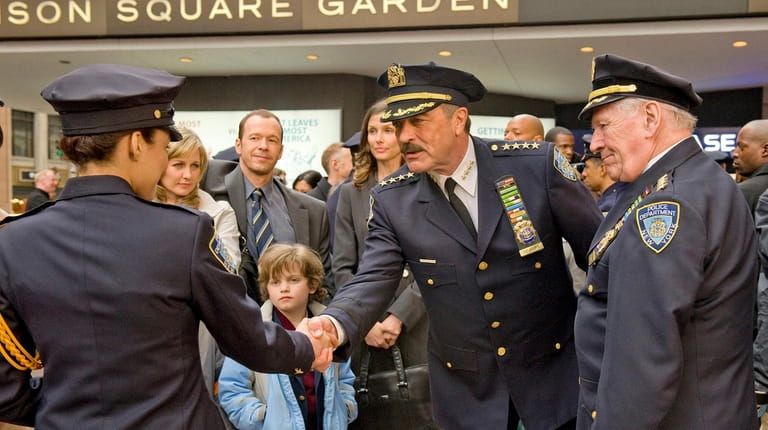Let the credits roll? Cuomo wants to extend film/TV tax breaks

"Shades of Blue," the TV show starring Jennifer Lopez as an NYPD detective, received $12.6 million in state tax credits. Credit: Alamy Stock Photo
ALBANY — Gov. Andrew M. Cuomo is proposing to reform the state’s $420 million a year tax break program for TV and film productions, but it’s not the reform that a growing chorus of critics of the tax credits are seeking.
Facing a $6.1 billion deficit, Cuomo’s budget proposal on Jan. 21 didn’t propose to reduce the nation’s highest tax credits — as 13 states have done to their programs since 2009. Instead, Cuomo proposed to lower the tax credit percentage for each applicant, which would allow more TV, film, and TV commercial productions to get a piece of it.
His proposal follows years in which many states have dropped or reduced their film and TV tax credit programs. Last fall, a University of Southern California study found “states investing the most in incentives are not getting the return on investment taxpayers deserve, pure and simple.” The study found New York has committed about $8 billion in tax credits since 2004, far more than the next highest state — Louisiana, which committed $3 billion since 2002.
Cuomo said the tax credits are needed to create and retain jobs.
“The Executive Budget extends the film credit for another year, through 2025, and reduces the credit rate to ensure the program is sustainable for years to come as the variety and number of productions taking place across New York State continues grow,” said Jason Conwall, Cuomo spokesman. “There’s mobility in the industry. With technological advances, you can shoot a movie anywhere … a story based in New York doesn’t have to be shot in New York.”
He said that without the credits, New York’s now established film and TV presence, which includes Grumman Studios and Gold Coast Studios in Bethpage, would see a “drastically reduced” presence in the job market.
“We have so many studios because of the growth. Yes, we would be able to maintain some of the activity, but not at the same level,” Conwall said.

"Blue Bloods," a TV show starring Tom Selleck as the New York City police commissioner, received $20.5 million in state tax credits. Credit: Alamy Stock Photo
State credits have supported many productions on Long Island, including the 2016 film “King Cobra” about a young gay porn star who was murdered. It was filmed partly in Nassau County and starred James Franco, Alicia Silverstone and Christian Slater. The production said it spent $766,021 in the state, hired 157 workers and was granted a tax credit of $125,897 in 2017, according to state records.
Other productions included “Shotgun,” a film yet to be screened, which was shot partly in Suffolk County. The production stated that it spent $1.7 million in the state, hired 417 people and was given a $327,551 tax credit in 2019.
In 2018, “Captain of the Land of Make Believe,” which was shot partly in Nassau County, spent $301,957, hired 61 people and received a tax credit of $59,710, and “Yellow Fever” was shot partly in Suffolk County, spent $181,701, hired 49 people and received a tax credit of $39,164.
“Simbi Zombies,” a film about half-siblings embarking on a music career, was shot partly in Nassau County, spent $34,498, hired 12 people and received a tax credit of $9,807.

Julia Louis-Dreyfus during her "Saturday Night Live" monologue on April 16, 2016. The show received $15.7 million in tax credits in 2018. Credit: NBCUniversal
In “Franny” Richard Gere played a billionaire suffering from addiction in a film that included Dakota Fanning. The production spent $295,029 in the state, hired six people, and received a tax credit of $82,188.
Cuomo’s budget would reduce the amount of a credit for a production to 25 percent, from 30 percent, of qualified expenses excluding the salaries of directors and actors. It also would reduce to 25 percent from 30 percent the credit for post-production work done in the New York City metro area, including Long Island, and reduce the post-production credit for work done elsewhere in the state to 30 percent, from 35 percent.
Cuomo's proposal also would exclude a TV series that seeks credits for a single episode produced in New York and would require a “qualified film” to have a budget of at least $1 million if the principal photography is not shot in New York City, Nassau, Suffolk or Westchester counties. The proposal also would exclude new variety programs, sketch shows and talk shows, except for those that had already received assistance, which include “Saturday Night Live” and “The Tonight Show Starring Jimmy Fallon.”
From 2004 and projected into 2024, the state has provided $7.3 billion to the multi-billion dollar film and TV industries, according to an analysis by the independent Citizens Budget Commission.
“They should be reducing the credit and an eye toward eliminating it,” said David Friedfel, director of state studies for the CBC. “Usually tax credits are used to establish a company … but this is an annual incentive for them to stay here. I think the New York film industry is well established and certainly a large number of them would stay.”
He credits Cuomo for reducing the percentages of benefits as “an acknowledgment that the existing credit is overly generous.”
Other states have pared or ended their film and tax incentives, according to the National Conference of State Legislatures. By 2009, 44 states had programs, but since then 13 states have ended theirs, marking “a larger trend of states re-evaluating or paring back film incentive programs” in the face of “unclear economic outcomes,” the group said.
“This is the biggest ongoing cash corporate subsidy provided by any state, on any basis, to any industry,” said E.J. McMahon of the fiscally conservative Empire Center think tank. “Reducing the maximum credit … slices the same big pie of $420 million a year into slightly smaller pieces, probably because many producers are complaining that there isn’t enough to go around.”
“Claims that this thing pays for itself are based on the assumption that nothing would be produced in New York without it, which is preposterous,” McMahon said.
The state has provided tax breaks to more than 73 TV series and more than 92 films, spawning $31 billion in spending that included hiring 1.9 million people, the Governor’s Office of Motion Picture and Television Development said. The program tracks "hires" rather than "workers" because many could be hired part-time or full-time for a day or a few weeks, rather than traditional full-time jobs, and workers hired more than once would be considered separate hires for state records.
The Cuomo administration wouldn't provide the number of permanent jobs created, saying the business operates on a production-by-production basis.
Parviz Farahzad, owner of Grumman Studios in Bethpage, estimated 90% to 95% of the productions that use his studio receive state tax credits.
"Without the credits, they would not be coming,” he said Friday.
Grumman's eight sound stages have been used for productions including NBC’s “Sound of Music Live!,” “The Amazing Spider-Man 2,” and “The Avengers.”
“The tax credit creates jobs and basically the productions have a trickle effect; they generate business for the local communities,” Farahzad said. “I think that overall the state will make that [tax credit] back.”
The program is a hit in Hollywood.
StudioBinder, a Hollywood consulting firm, states on its website: “Your film budget isn’t complete until you factor in taxes. What if you were told you could magically get some of that moola back? That’s right, I’m talking film tax credits, baby … whether or not film credits actually work, however, is up for debate … so filmmakers, get ‘em while they’re hot.”
The state’s program differs from other economic development programs. For example, the $420 million annual allocation is a “soft cap,” and more credits are borrowed from future years as needed.
“We have that ability to tap into future years,” said Cuomo’s Conwall. “We have tried not to.”
Further, most state economic development programs require specific criteria to count toward the obligation needed to qualify for tax credits. While most programs require a job to be full-time for six months or similar threshold, the state's film and TV tax credits count a job even if it lasts just one day, which Cuomo officials say reflects the unique operation of TV and movie projects.
“I’m not aware of anything that is structured in a similar manner,” the CBC’s Freidfel said.
Cuomo has collected more than $863,000 in campaign contributions from California-based studios, producers, directors and actors since he’s been in office, state records show.
A November 2017 fundraising dinner was held at the Los Angeles home of HBO executive James Costas and attendees included director and liberal activist Rob Reiner and director J.J. Abrams. Other fundraisers have attracted donations from director/producer Steven Spielberg, who donated a total of $35,000 in 2014 and 2015 along with his wife, actress Kate Capshaw, who gave another $25,000.
At the November 2017 fundraiser, donors thanked Cuomo for New York’s tax credits, and his successful effort to legalize same-sex marriage, according to local press reports.
The University of Southern California study found little to praise in New York's program.
“My research showed that despite substantial investment, New York's tax incentive for film and television production had no effect on employment,” the researcher, Michael Thom, told Newsday. “While the proposed reforms are well intentioned, New York taxpayers should demand that their representatives repeal the incentive outright.”
The Cuomo administration disputes the findings of the peer-reviewed study, calling the data incomplete and questioning its methodology.
Meanwhile, criticis of the program say state funding can be better spent at a time when the budget includes a $6.1 billion deficit.
“Instead of providing tax credits to the film industry we would be better served by strengthening tax credits to struggling New Yorkers by enhancing the Earned Income Tax Credit," said Ron Deutsch, executive director of the labor-backed Fiscal Policy Institute.
State reports show New York’s tax credits currently include:
$12.6 million for the TV show “Shades of Blue” that stars Jennifer Lopez as a NYPD detective.
$20.5 million for “Blue Bloods,” a TV show starring Tom Selleck as the New York City police commissioner.
$15.7 million for “Saturday Night Live” in 2018

